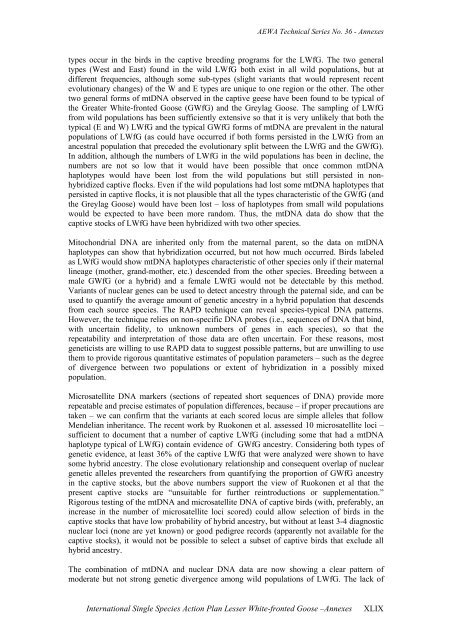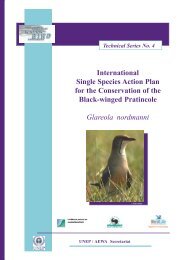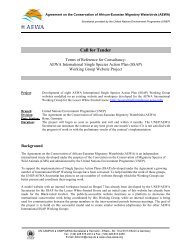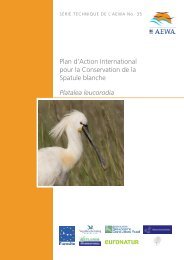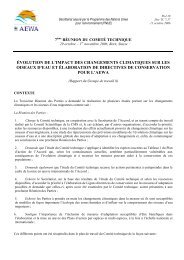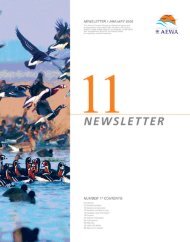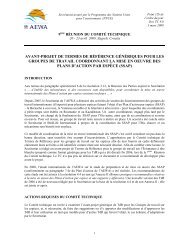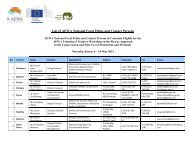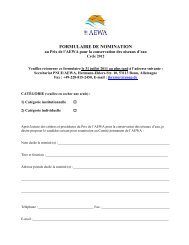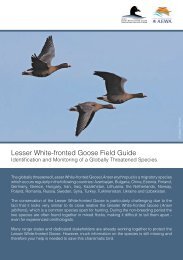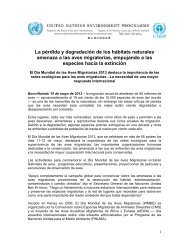International Single Species Action Plan for the ... - AEWA
International Single Species Action Plan for the ... - AEWA
International Single Species Action Plan for the ... - AEWA
Create successful ePaper yourself
Turn your PDF publications into a flip-book with our unique Google optimized e-Paper software.
<strong>AEWA</strong> Technical Series No. 36 - Annexes<br />
types occur in <strong>the</strong> birds in <strong>the</strong> captive breeding programs <strong>for</strong> <strong>the</strong> LWfG. The two general<br />
types (West and East) found in <strong>the</strong> wild LWfG both exist in all wild populations, but at<br />
different frequencies, although some sub-types (slight variants that would represent recent<br />
evolutionary changes) of <strong>the</strong> W and E types are unique to one region or <strong>the</strong> o<strong>the</strong>r. The o<strong>the</strong>r<br />
two general <strong>for</strong>ms of mtDNA observed in <strong>the</strong> captive geese have been found to be typical of<br />
<strong>the</strong> Greater White-fronted Goose (GWfG) and <strong>the</strong> Greylag Goose. The sampling of LWfG<br />
from wild populations has been sufficiently extensive so that it is very unlikely that both <strong>the</strong><br />
typical (E and W) LWfG and <strong>the</strong> typical GWfG <strong>for</strong>ms of mtDNA are prevalent in <strong>the</strong> natural<br />
populations of LWfG (as could have occurred if both <strong>for</strong>ms persisted in <strong>the</strong> LWfG from an<br />
ancestral population that preceded <strong>the</strong> evolutionary split between <strong>the</strong> LWfG and <strong>the</strong> GWfG).<br />
In addition, although <strong>the</strong> numbers of LWfG in <strong>the</strong> wild populations has been in decline, <strong>the</strong><br />
numbers are not so low that it would have been possible that once common mtDNA<br />
haplotypes would have been lost from <strong>the</strong> wild populations but still persisted in nonhybridized<br />
captive flocks. Even if <strong>the</strong> wild populations had lost some mtDNA haplotypes that<br />
persisted in captive flocks, it is not plausible that all <strong>the</strong> types characteristic of <strong>the</strong> GWfG (and<br />
<strong>the</strong> Greylag Goose) would have been lost – loss of haplotypes from small wild populations<br />
would be expected to have been more random. Thus, <strong>the</strong> mtDNA data do show that <strong>the</strong><br />
captive stocks of LWfG have been hybridized with two o<strong>the</strong>r species.<br />
Mitochondrial DNA are inherited only from <strong>the</strong> maternal parent, so <strong>the</strong> data on mtDNA<br />
haplotypes can show that hybridization occurred, but not how much occurred. Birds labeled<br />
as LWfG would show mtDNA haplotypes characteristic of o<strong>the</strong>r species only if <strong>the</strong>ir maternal<br />
lineage (mo<strong>the</strong>r, grand-mo<strong>the</strong>r, etc.) descended from <strong>the</strong> o<strong>the</strong>r species. Breeding between a<br />
male GWfG (or a hybrid) and a female LWfG would not be detectable by this method.<br />
Variants of nuclear genes can be used to detect ancestry through <strong>the</strong> paternal side, and can be<br />
used to quantify <strong>the</strong> average amount of genetic ancestry in a hybrid population that descends<br />
from each source species. The RAPD technique can reveal species-typical DNA patterns.<br />
However, <strong>the</strong> technique relies on non-specific DNA probes (i.e., sequences of DNA that bind,<br />
with uncertain fidelity, to unknown numbers of genes in each species), so that <strong>the</strong><br />
repeatability and interpretation of those data are often uncertain. For <strong>the</strong>se reasons, most<br />
geneticists are willing to use RAPD data to suggest possible patterns, but are unwilling to use<br />
<strong>the</strong>m to provide rigorous quantitative estimates of population parameters – such as <strong>the</strong> degree<br />
of divergence between two populations or extent of hybridization in a possibly mixed<br />
population.<br />
Microsatellite DNA markers (sections of repeated short sequences of DNA) provide more<br />
repeatable and precise estimates of population differences, because – if proper precautions are<br />
taken – we can confirm that <strong>the</strong> variants at each scored locus are simple alleles that follow<br />
Mendelian inheritance. The recent work by Ruokonen et al. assessed 10 microsatellite loci –<br />
sufficient to document that a number of captive LWfG (including some that had a mtDNA<br />
haplotype typical of LWfG) contain evidence of GWfG ancestry. Considering both types of<br />
genetic evidence, at least 36% of <strong>the</strong> captive LWfG that were analyzed were shown to have<br />
some hybrid ancestry. The close evolutionary relationship and consequent overlap of nuclear<br />
genetic alleles prevented <strong>the</strong> researchers from quantifying <strong>the</strong> proportion of GWfG ancestry<br />
in <strong>the</strong> captive stocks, but <strong>the</strong> above numbers support <strong>the</strong> view of Ruokonen et al that <strong>the</strong><br />
present captive stocks are “unsuitable <strong>for</strong> fur<strong>the</strong>r reintroductions or supplementation.”<br />
Rigorous testing of <strong>the</strong> mtDNA and microsatellite DNA of captive birds (with, preferably, an<br />
increase in <strong>the</strong> number of microsatellite loci scored) could allow selection of birds in <strong>the</strong><br />
captive stocks that have low probability of hybrid ancestry, but without at least 3-4 diagnostic<br />
nuclear loci (none are yet known) or good pedigree records (apparently not available <strong>for</strong> <strong>the</strong><br />
captive stocks), it would not be possible to select a subset of captive birds that exclude all<br />
hybrid ancestry.<br />
The combination of mtDNA and nuclear DNA data are now showing a clear pattern of<br />
moderate but not strong genetic divergence among wild populations of LWfG. The lack of<br />
<strong>International</strong> <strong>Single</strong> <strong>Species</strong> <strong>Action</strong> <strong>Plan</strong> Lesser White-fronted Goose –Annexes<br />
XLIX


